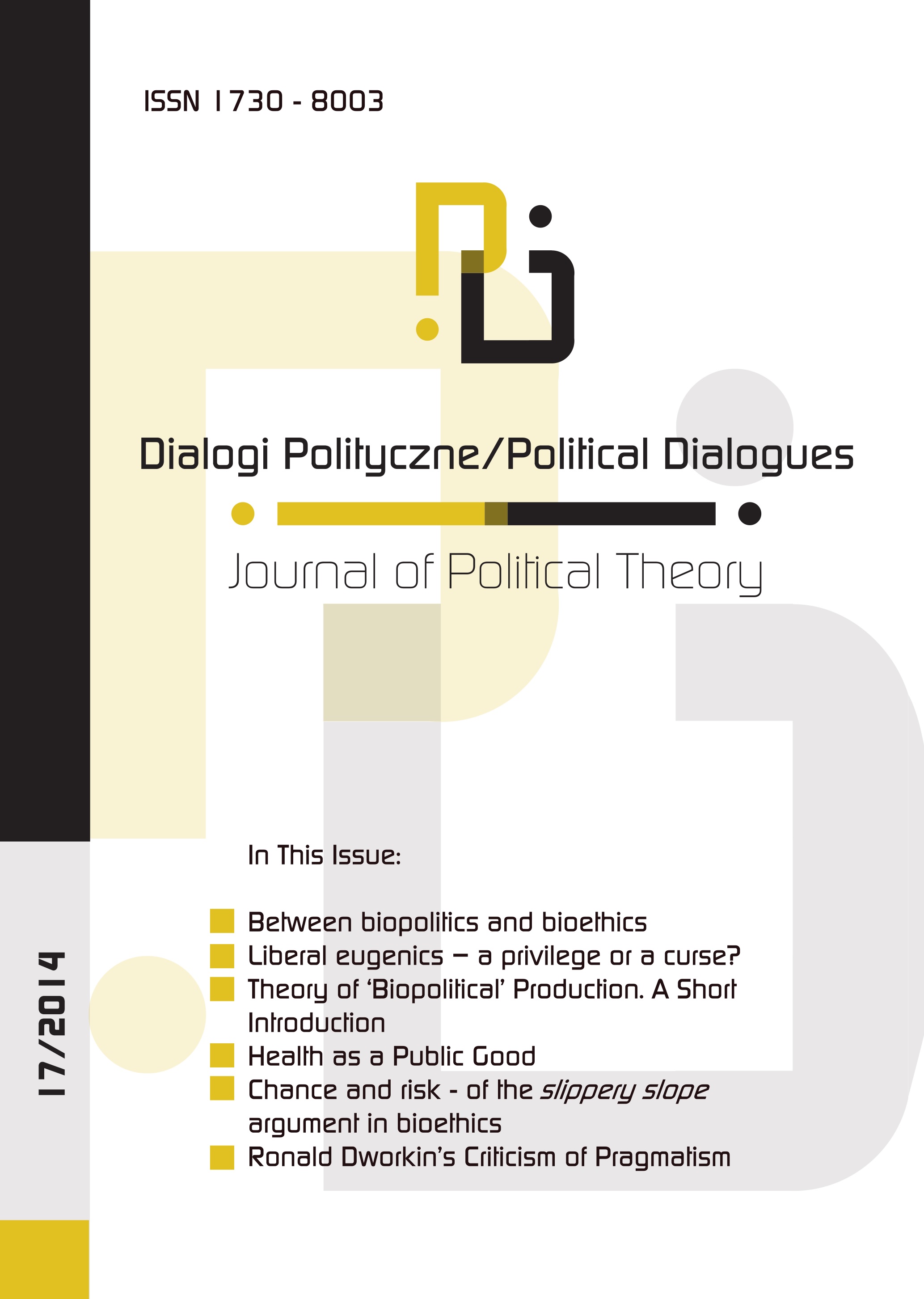Eugenika libearalna - przywilej czy przekleństwo?
DOI:
https://doi.org/10.12775/DP.2014.011Abstrakt
Esej rozważa konsekwencje powołania do życia dzieci na zamówienie oraz zbawczego rodzeństwa. Przedstawia możliwe skutki socjologiczne, psychologiczne, etyczne i medyczne. Wskazuje zagrożenia dla tożsamości i osobowości dzieci, a także ich rozwoju psychospołecznego, oraz relacji rodzinnych, zarówno w skali pojedynczej komórki społecznej, jak i międzynarodowej sieci połączeń interpersonalnych. Esej nakreśla także sytuację prawno-medyczną w wybranych krajach oraz stanowisko Human Fertilisation and Embryology Authority. W zakończeniu zaś stawia pytania, których rozstrzygnięcie pozostaje w gestii czytelnika oraz przedstawia stanowisko autorki.
Bibliografia
B. Dickens, Preimplantation genetic diagnosis and 'savior siblings', „International Journal of Gynecology and Obstetrics”, 88, 2005, s. 91-96.
Editors of Scientific American, Designing Rules for Designer Babies, „American Scientific”, 300, 2009, s. 29.
R. Figueira, A. Setti, S. Cortezzi, C. Martinhago ,D. Braga, A. Iaconelli Jr. E. Borges Jr., Preimplantation diagnosis for β-thalassemia combined with HLA matching: first “savior sibling” is born after embryo selection in Brazil, „Journal of Assisted Reproduction and Genetics”, 29, 2012.
D. Fox, The Illiberality of ' Liberal Eugenics', „Ratio (new series)”, XX, 2007, s. 1-25
F. Fukuyama, Koniec człowieka. Konsekwencje rewolucji biotechnologicznej, przeł. B. Pietrzyk, Kraków, 2004.
R. Iredale, M. Longley, C. Thomas, A. Shaw, What choices should we be able to make about designer babies? A Citizens’ Jury of young people in South Wales, „Health Expectations”, 9, 2006, s. 207-217.
M. H. Johnson, A moral case study for discussion: designer babies and tissue typing, „Reproductive BioMedicine Online,” 9, 2004, s. 372.
S. Lam, Ilustrowana encyklopedia Trzaski, Everta i Michalskiego, t.16, Warszawa 1997, s. 490.
I. de Melo-Martin, On our obligation to select the best baby: A reply to Savulescu, „Bioethics”, 18, 2004, s. 72-83.
B. Mepham, Bioetyka: wprowadzenie dla studentów nauk biologicznych, red. P. Łuków, przeł. E. Bartnik, P. Golik, J.Klimczyk,Warszawa, 2008.
M. Sandel, The Case Against Perfection. Harvard, 2007, s.45–46.
J. Savulescu M. Hemsley, A. Newson, B. Foddy, Behavioural Genetics: Why Eugenic Selection is Preferable to Enhancement, Journal of Applied Philosophy, 23, 2006, s. 157-171.
J. Savulescu, G. Kahanne, The moral obligation to create children with the best chance of the best life, „Bioethics”, 23, 2009, s. 274-290.
J. Savulescu, Deaf Lesbians, „Designer Disability” and The Future of The Medicine, „British Medicinal Journal”, 325, 2002, s. 771-773.
J. Savulescu, Procreative Beneficience: Why we should select the best children, „Bioethics”, 15, 2001, s. 413-426.
S. Sheldon, S. Wilkinson, Should selecting saviour siblings be banned?, „Journal of Medical Ethics”, 30, 2004, s. 533-537.
M. Spriggs, J. Savulescu, 'Saviour siblings', „Journal of Medical Ethics”, 28, 2002, s. 289.
B. Steinbock, The art of medicine. Designer babies: Choosing our children's genes, „The Lancet”, 372, 2008, s. 1294-1295.
S. E. Stoller, Why we are not morally reqiured to select the best children: a response to Savulescu, „Bioethics”, 22, 2008, s. 364-369.
K. Strong, I. Kerridge, M. Little, Savior siblings, parenting, and the moral valorization of children, „Bioethics”, 2002, s. 1-7.
Y. Verlinsky, S. Rechitsky, W. Schoolcraft, Ch. Strom, A Kuliev, Designer babies – are they a reality yet? Case report: simultaneous preimplantation genetic diagnosis for Fanconi anaemia and HLA typing for cord blood transplantation, „Reproductive BioMedicine Online”, 1, 2000, s. 31.
N. Williams, 'Designer' babies, „Current Biology,” 14, 2004, s. 594.
Pobrania
Opublikowane
Jak cytować
Numer
Dział
Statystyki
Liczba wyświetleń i pobrań: 512
Liczba cytowań: 0



